《国际商务谈判》第二章
- 格式:pdf
- 大小:908.62 KB
- 文档页数:59
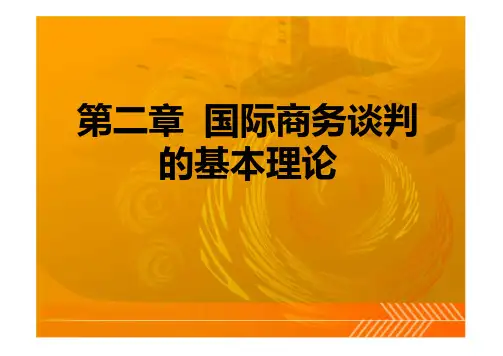
第二章国际商务谈判的基本理论•第一节结构理论及其在国际商务谈判中的应用•第二节需求理论及其在国际商务谈判中的应用•第三节行为学理论及其在国际商务谈判中的应用•第四节心理学理论及其在国际商务谈判中的应用•第五节博弈论及其在国际商务谈判中的应用•上世纪50年代至今,美日之间的贸易摩擦与贸易谈判绵延不绝,在现代贸易史上极具代表性和典型性。
美日贸易谈判,无论在过程结构和实力结构、行为、心理,以及谈判层次、类型、频率、对象和方式上都有较大的研究价值。
•二战后,日本经济在较短时间内得以恢复并实现了赶超,上世纪60年代末就成为西方世界第二经济大国和强国。
不过,与此相伴随,上世纪50年代中后期开始,日本就与美国在纺织品、皮革贸易上发生了摩擦,此后一路升级,在钢铁、家电、机床、汽车、半导体等领域的贸易摩擦愈演愈烈,日本经济实力的增强也让美国产生了较大的警惕心理,“日本威胁论”喧嚣一时。
•1985年9月,《广场协议》签署后,日元大幅度升值,却并没有改变美日贸易失衡的局面,日本对美贸易顺差仍然居高不下,贸易政策成为美国对外关系的焦点议题。
美国国会通过了《1988年综合贸易与竞争法》之后,美国开始寻求与日本进行贸易谈判,日本也意识到应该把谈判作为一种管控美日经济关系困境的方式。
•1989年7月,美日贸易谈判开启。
两国共同组建了一个联合工作小组,其中包括美国的六个部门,国务院、财政部、贸易代表为三个共同主席,还有商务部、司法部和经济顾问委员会。
日本的外务省、大藏省、通产省(经产省前身)为三个共同主席,经济企划厅和公平贸易委员会是小组成员。
随着谈判的不断深入,联合小组也有所扩大,不断有其他部门加入到谈判当中。
•第一阶段谈判于1989年9月4日至1990年1月30日进行。
由于美日各执一词,双方分歧较为严重,谈判进展缓慢,一度陷入僵局。
美国列出了240项条款清单,涉及事项繁多,使得日本深为不满。
美国国内舆论则要求对日本采取更为强硬的政策,两国政治经济关系陷入紧张状态。

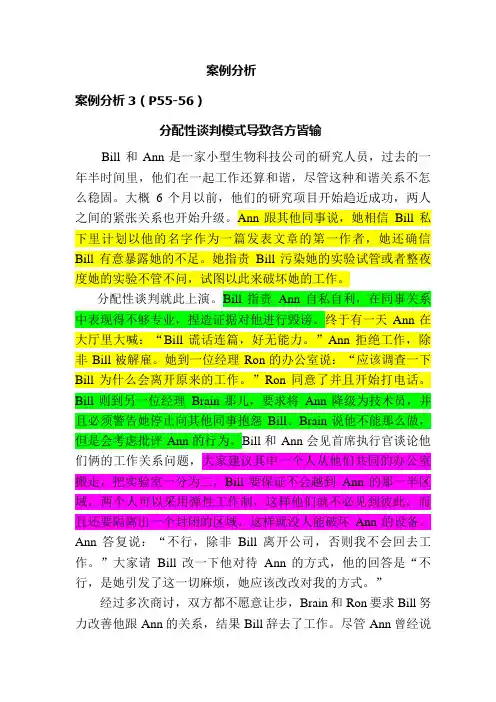
案例分析案例分析3(P55-56)分配性谈判模式导致各方皆输Bill 和Ann是一家小型生物科技公司的研究人员,过去的一年半时间里,他们在一起工作还算和谐,尽管这种和谐关系不怎么稳固。
大概6个月以前,他们的研究项目开始趋近成功,两人之间的紧张关系也开始升级。
Ann跟其他同事说,她相信Bill私下里计划以他的名字作为一篇发表文章的第一作者,她还确信Bill有意暴露她的不足。
她指责Bill污染她的实验试管或者整夜度她的实验不管不问,试图以此来破坏她的工作。
分配性谈判就此上演。
Bill指责Ann自私自利,在同事关系中表现得不够专业,捏造证据对他进行毁谤。
终于有一天Ann在大厅里大喊:“Bill 谎话连篇,好无能力。
”Ann拒绝工作,除非Bill被解雇。
她到一位经理Ron的办公室说:“应该调查一下Bill为什么会离开原来的工作。
”Ron同意了并且开始打电话。
Bill则到另一位经理Brain那儿,要求将Ann降级为技术员,并且必须警告她停止向其他同事抱怨Bill。
Brain说他不能那么做,但是会考虑批评Ann的行为。
Bill和Ann会见首席执行官谈论他们俩的工作关系问题,大家建议其中一个人从他们共同的办公室搬走,把实验室一分为二,Bill要保证不会越到Ann的那一半区域,两个人可以采用弹性工作制,这样他们就不必见到彼此,而且还要隔离出一个封闭的区域,这样就没人能破坏Ann的设备。
Ann答复说:“不行,除非Bill离开公司,否则我不会回去工作。
”大家请Bill改一下他对待Ann的方式,他的回答是“不行,是她引发了这一切麻烦,她应该改改对我的方式。
”经过多次商讨,双方都不愿意让步,Brain和Ron要求Bill努力改善他跟Ann的关系,结果Bill辞去了工作。
尽管Ann曾经说如果Bill离职她就回来工作,现在她却说受够了这种对感情的伤害,因此不想再回来了。
谈论问题:(1)你认为如何能够将这种分配式谈判转变为整合式谈判?(2)案例中两败俱伤的结果能够避免吗?参考答案:(1)将这种分配式谈判转变为整合式谈判需要找到二者的利益共同点:都希望研究项目取得成功,并从中取得报酬。
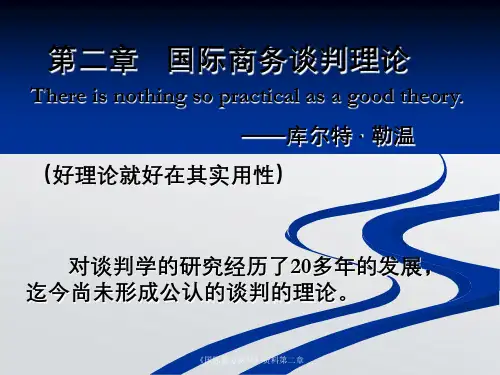

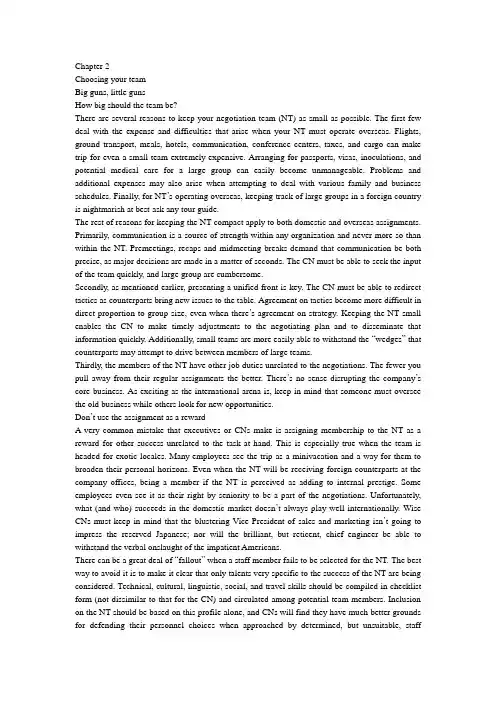
Chapter 2Choosing your teamBig guns, little gunsHow big should the team be?There are several reasons to keep your negotiation team (NT) as small as possible. The first few deal with the expense and difficulties that arise when your NT must operate overseas. Flights, ground transport, meals, hotels, communication, conference centers, taxes, and cargo can make trip for even a small team extremely expensive. Arranging for passports, visas, inoculations, and potential medical care for a large group can easily become unmanageable. Problems and additional expenses may also arise when attempting to deal with various family and business schedules. Finally, for NT’s operating overseas, keeping track of large groups in a foreign country is nightmarish at best-ask any tour guide.The rest of reasons for keeping the NT compact apply to both domestic and overseas assignments. Primarily, communication is a source of strength within any organization and never more so than within the NT. Premeetings, recaps and midmeeting breaks demand that communication be both precise, as major decisions are made in a matter of seconds. The CN must be able to seek the input of the team quickly, and large group are cumbersome.Secondly, as mentioned earlier, presenting a unified front is key. The CN must be able to redirect tactics as counterparts bring new issues to the table. Agreement on tactics become more difficult in direct proportion to group size, even when there’s agreement on strategy. Keeping the NT small enables the CN to make timely adjustments to the negotiating plan and to disseminate that information quickly. Additionally, small teams are more easily able to withstand the “wedges” that counterparts may attempt to drive between members of large teams.Thirdly, the members of the NT have other job duties unrelated to the negotiations. The fewer you pull away from their regular assignments the better. There’s no sense disrupting the company’s core business. As exciting as the international arena is, keep in mind that someone must oversee the old business while others look for new opportunities.Don’t use the assignment as a rewardA very common mistake that executives or CNs make is assigning membership to the NT as a reward for other success unrelated to the task at hand. This is especially true when the team is headed for exotic locales. Many employees see the trip as a minivacation and a way for them to broaden their personal horizons. Even when the NT will be receiving foreign counterparts at the company offices, being a member if the NT is perceived as adding to internal prestige. Some employees even see it as their right by seniority to be a part of the negotiations. Unfortunately, what (and who) succeeds in the domestic market doesn’t always play well internationally. Wise CNs must keep in mind that the blustering Vice President of sales and marketing isn’t going to impress the reserved Japanese; nor will the brilliant, but reticent, chief engineer be able to withstand the verbal onslaught of the impatient Americans.There can be a great deal of “fallout” when a staff member fails to be selected for the NT. The best way to avoid it is to make it clear that only talents very specific to the success of the NT are being considered. Technical, cultural, linguistic, social, and travel skills should be compiled in checklist form (not dissimilar to that for the CN) and circulated among potential team members. Inclusion on the NT should be based on this profile alone, and CNs will find they have much better grounds for defending their personnel choices when approached by determined, but unsuitable, staffmembers. This is especially true when other executives and managers assume they’re going to be part of the NT. As a way of preserving morale among those left off of the NT roster, some CNs make the deferrees part of the prenegotiation strategy planning process.A balance of skills and strengthsIt’s unlikely that any single team member will embody all of the talents necessary to achieve the company’s strategy. The CN must choose a cross-section of technical skills and personal attributes that will create a compact and efficient team. One team member’s weakness must be offset by another’s strength. Technical prowess must be a accompanied by the ability to communicate and apply that prowess. Putting a team together is similar to assembling a jigsaw puzzle: there’s no success unless all of the pieces fit.A common practice among experienced travelers when packing for trips is to never put anything in the suitcase that has “only one use”; the same applies to choosing NT members. A specialist candidate is eschewed in favor of the generalist unless the technical expertise is absolutely crucial to the effort. If the CN must include these “one trick ponies,” every attempt should be made to make them a part of the wider strategy and tactics discussions. If that’s unsuccessful, these specialist members should be cautioned to advise in private during negotiations and to avoid direct involvement.Painting the “big picture”Although many technical types will disagree, it’s much easier to impart technical knowledge to a good communicator than it is to do the reverse. Members of the NT must be chosen for their ability to effectively execute the company’s strategy and to quickly respond to the tactics of counterparts. This is accomplished only through good communications skills. Scientific and financial technical skills will take a back seat, especially during initial negotiations, as the “big picture” is discussed. Details will be left until much later in the process. Many business cultures prefer to have the details tended to after the contract is signed.Bringing massive technical data to the negotiating table may only slow down the deal-making process.NOTE: Much “expertise can be carried in file or laptop form, in case it should be needed during discussions.Tasks Both Large and smallMajor decisions are made every day during negotiations, but not all of the work is momentous. Some companies and consultant CNs make the mistake of including only “big guns” on the team. This causes problems, as no one relishes doing the necessary but tedious (and decidedly unglamorous ) work that keeps negotiations running smoothly—getting copies, typing policy changes, taking notes, arranging dinners, and so on .Including a few junior managers or administrators in the ranks of the NT for the sole purpose of controlling logistics is a wise move. This is particularly helpful if these members have experience working or traveling in the target market. Should the finances or domestic needs of the company preclude this option, these administrative duties should be assigned to specific members of the team, and it should be made clear that these duties are as important as any of the ,more “spot light”tasks. As is true in other areas of business, what happens behind the scenes determines success on the stage.Home Team Versus VisitorsThe respective sizes of the NT is usually determined by the group that’s visiting.This is particularly true if the visiting team is in the position of . “buying” from the home team or receiving group. The visiting group should forward a list of its members, stipulating the job title and responsibility of each. The receiving group should assemble their NT to correspond to the visiting team.It’s true that the receiving team has the psychological advantage of operating from their home turf, but they should resist the urge to overwhelm their visitors with an imposingly large NT. Since these resources can be called upon at any time, it’s best to see if they, re needed before arraying them. The ability to successfully exploit the discomfort of counterparts is very much related to one’s culture and requirements for a “success”. Some visitors may be in awe of your facilities and staff while others may consider it a visitors may be in awe of your is generally better when making initial contact.“Observer” TrainingCompanies that regularly pursue international trade and investment like to use negotiation as an ongoing training tool by purposely including less experienced members on the team. This allows them to gain experience that can be put to use in future international negotiations. It’s best to make it clear to these junior team members exactly why they’re being included in the NT so that they’re keen to gain as much experience as possible, get “bloodied” by their own mistakes, and learn from those of other team members .It’s also an ideal way for the company to see how their future CNs handle new and difficult situations. Many executives will attest to the fact that the “rising stars from the home office often become confused and ill-at-ease when put into the crucible of international negotiations and travel. Conversely, the mediocre manager may flourish in the new international environment.Those Who Can’“CUT IT”A common question in business when determining whether someone will be a success is , “Can they cut the muster?” (Sorry, folks, it isn’t mustard.) During the Middle Ages, the muster in question was the final pattern cut from cloth by journeymen to be used by the master tailor. Cut improperly, the pattern will never work, and valuable cloth will be ruined. International negotiations have a similar one-chance-is-all-you-get sense of finality. The NT acts as the journeymen and the CN is the master tailor preparing to stitch together a successful negotiation. Below are some types of people to avoid because they won’t be able “to cut it.”WHINERSEmployees who constantly complain, even under good conditions, are going to find travel and the stress of negotiations intolerable. These types love to bring up problems but never offer solutions. Every company has them, but successful negotiating teams don’t.CONNIVERSUnity is paramount for negotiations and people who like to work their own agenda or jockey for position will only undermine the team’s effort. These types are generally keen strategies and they may be useful in planning. However, under no circumstances should they ever take an active role in negotiations.HOTHOUSE FLOWERSMore competent than whiners, these “high maintenance”types can only excel under ideal circumstances. They never complain but are easily set back by the slightest deviation form the norm. Unfortunately, negotiations and overseas travel are rarely conducive to ideal anything. Sometimes, the NT must operate when materials and equipment are lost, or work in environmentsin which electricity is some trials reserved for special occasions. Technically astute or not, these “flowers” won’t travel well. If they must be used, do so only when negotiations are on home turf. An overseas team needs those that can adapt to any environment.BIGOTSNegotiations are a zero-sun game based on finding common ground amid very real and distinct differences. Adding racial, cultural, or class bigotry will only obscure an already complex state of affairs. Bigots (of any ilk) tend to communicate their prejudices more than they realize, and it’s not the kind of communication that leads to a successful deal.The frailRegardless of where the team originated, the world outside of the domestic market is filled with sights, sounds, smells, and tastes that pummel the visitor. Part of the success of the NT will be in its ability to assimilate as quickly as possible into the environment of their target market. The hygienic and culinary habits of counterparts and their culture may not meet the standards of the NT’s domestic scene. Members who can’t quickly and adequately adjust to new environments will only be a burden to the whole team, thus disrupting strategies and assignments. Like the CN, the team must be robust.Overseas? Domestic? One core team?Optimally, once a team is assembled, it should be used for both overseas and domestic negotiations related to international business. (Specialists may be added for individual negotiations.) This is especially true for smaller companies with limited resources. But large companies should not make the mistake of having two separate teams-one for overseas and one for domestic discussions-simply because they can afford the expense. Teams that have operated overseas will understand the stresses and strains being exerted on foreign teams when they come for business visits. This information, used sympathetically or otherwise, can be a key part of the overall strategy and daily tactics. Lastly, using the team for all negotiations will add to its ability to operate as a unit as team members become expert at all aspects of negotiating. They must be able to visit as well as host a negotiation and understand the responsibilities of being on either side of the table.。
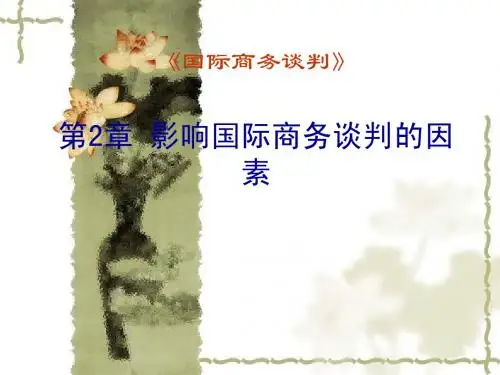

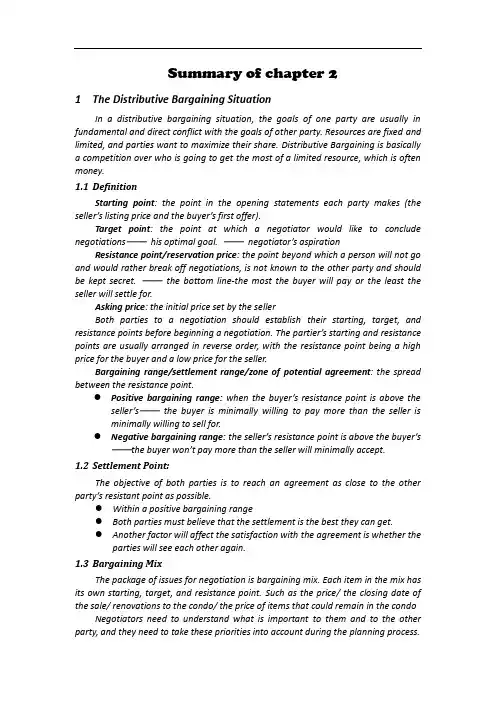
Summary of chapter 21The Distributive Bargaining SituationIn a distributive bargaining situation, the goals of one party are usually in fundamental and direct conflict with the goals of other party. Resources are fixed and limited, and parties want to maximize their share. Distributive Bargaining is basically a competition over who is going to get the most of a limited resource, which is often money.1.1DefinitionStarting point: the point in the opening statements each party makes (the seller’s listing price and the buyer’s first offer).Target point: the point at which a negotiator would like to conclude negotiations——his optimal goal. ——negotiator’s aspirationResistance point/reservation price: the point beyond which a person will not go and would rather break off negotiations, is not known to the other party and should be kept secret. ——the bottom line-the most the buyer will pay or the least the seller will settle for.Asking price: the initial price set by the sellerBoth parties to a negotiation should establish their starting, target, and resistance points before beginning a negotiation. The partier’s starting and resistance points are usually arranged in reverse order, with the resistance point being a high price for the buyer and a low price for the seller.Bargaining range/settlement range/zone of potential agreement: the spread between the resistance point.⚫Positive bargaining range: when the buyer’s resistance point is above the seller’s——the buyer is minimally willing to pay more than the seller isminimally willing to sell for.⚫Negative bargaining range: the seller’s resistance point is above the buyer’s ——the buyer won’t pay more than the seller will minimally accept.1.2Settlement Point:The objective of both parties is to reach an agreement as close to the other party’s resistant point as possible.⚫Within a positive bargaining range⚫Both parties must believe that the settlement is the best they can get.⚫Another factor will affect the satisfaction with the agreement is whether the parties will see each other again.1.3Bargaining MixThe package of issues for negotiation is bargaining mix. Each item in the mix has its own starting, target, and resistance point. Such as the price/ the closing date of the sale/ renovations to the condo/ the price of items that could remain in the condo Negotiators need to understand what is important to them and to the other party, and they need to take these priorities into account during the planning process.1.4Fundamental Strategies1.4.1Discovering the other party’s resistance pointThe more you can learn about the other party’s target, resistance point, motives, feelings of confidence, and so on, the more able you will be to strike a favorable agreement.To influence the other party’s perception, however, they must establish some points effectively and convincingly.1.4.2Influencing the other party’ s resistance pointFactors are important in attempting to influence the other party’s resistance point:(1) the value the other attaches to a particular outcome(2) the cost the other attaches to delay or difficulty in negotiations(3) the cost the other attaches to having the negotiation aborted.A significant factor in shaping the other person’s understanding of what is possible is the other’s understanding of your own situation.1.4.3Propositions:1. The higher the other party’s estimate of your cost of delay or impasse, the stronger the other party’s resistance point will be.2. The higher the other party’s estimate of his or her own cost of delay or impasse, the weaker the other party’s resistance point will be.3. The less the other values an issue, the lower their resistance point will be.4. The more the other believes that you value an issue, the lower their resistance point may be.Case:In the condo example, the buyer has four fundamental strategies available:(1) To push for a settlement close to the seller’s resistance point. $ 130,000(2) To convince the seller to change her resistance point.(3) If a negative settlement range exists, to convince the seller to reduce her resistance point.(4) To convince the seller to believe that this settlement is the best that is possible.2Tactical TasksThere are four important tactical tasks for a negotiator in a distributive bargaining situation to consider:2.1Assess the other party’s target, resistance point, and cost of terminating negotiation.The negotiator can pursue two general routes to achieve this task:⚫Obtain information indirectly about the background factors behind an issue (indirect assessment).⚫Obtain information directly from the other party about their target andresistance point (direct assessment) .2.2Manage the other party’s impressions of a negotiator’s target, resistance point, and cost of terminating negotiation.An important tactical task for negotiators is to control the information sent to the other party about your target and resistance points, while simultaneously guiding him or her to form a preferred impression of them.Negotiators need to screen information about their positions and to represent them as they would like the other to believe them.⚫Screening Activities.The simplest way to screen a position is to say and do as little as possible. “Silence is gold.”Another approach, available when group negotiations are conducted through a representative is calculated incompetence.Reduce the number of people who can actively reveal information.Present a great many items for negotiations only a few of which are truly important to the presenter.⚫Direct Action to Alter Impressions.Many actions can be taken to present facts that will that will enhance their position or make it appear stronger to the other party.Negotiators should justify their positions and desired outcomes in order to influence the other party’s impressions.Displaying emotional reaction to facts, proposals, and possible outcomes is another form of direct action.Taking direct action to alter another’s impression raises several potential hazards.2.3Modify the other party’s perceptions of his own target, resistance point, and cost of terminating negotiation.⚫Interpret for the other party what the outcomes of his or her proposal will be.⚫Conceal information.2.4Manipulate the other party’s actual cost of delaying or terminating negotiation.(1) Disruptive Action. Increase the cost of not reaching a negotiated agreement.(2) Alliance with Outsiders. Involve the other parties who can somehow influence the outcomes in the process.(3) Schedule Manipulation. The negotiation scheduling process can often put one party at a considerable disadvantage. The opportunities to increase or alter the timing of negotiation vary widely across negotiation domain.3Position Taken during NegotiationEffective distributive bargainers need to understand the process of makingpositions during bargaining, including the importance of opening offer, opening stance, and the role of making concessions throughout the negotiation process.3.1Opening OffersThe fundamental question is whether the opening offer should be exaggerated or modest.There are at least two reasons that an exaggerated opening offer is advantageous.Two disadvantageous of exaggerated opening offer are:(1) It maybe summarily rejected by the other party(2) it communicates an attitude of toughness that maybe harmful to long-term relationships.3.2Opening StanceWill you be competitive or moderate? It is important for negotiators to think carefully about the messages that the wish to signal with their opening stance and subsequent concessions. To communicate effectively, a negotiator should try to senda consistent messages through both opening offer and stance.3.3Initial ConcessionsFirst concession conveys a message, frequently a symbolic one to the other party that how you will proceed.Firmness may actually shorten negotiations, there is also the very real possibility, however, it will be reciprocated by the other.There are good reasons for adopting a flexible position.3.4Role of ConcessionsConcessions are central to negotiation. Negotiators also generally resent a take-it-or-leave-it approach. Parties feel better about a settlement when the negotiation involved a progression of concession. A reciprocal concession cannot be haphazard.To encourage further concession from the other party, negotiators sometimes link their concessions to a prior concession made by the other party.3.5Final OffersA negotiator might simply let the absence of any further concessions that convey the message in spite of urging the other party.One way negotiators may convey the message that an offer is the one is to make the last concession more substantial.4Commitment4.1Establishing a CommitmentA commitment statement has three properties: a high degree of finality, ahigh degree of specificity, and a clear statement of consequences.Several ways to create a commitment:⚫public pronouncement⚫linking with an outside base⚫increase the prominence of demands⚫reinforce the threat or promise4.2Preventing the other party from committing prematurelyOne way to prevent the other party from establishing a committed position is to deny his or her the necessary time.Another approach is to ignore or downplay a threat by not acknowledging the other party’s commitment, or even by making a joke about it.There are times, however, when itis to a negotiator’s advantageous for the other party become committed.4.3Finding ways to abandon a committed positionFour avenues for escaping commitment:⚫Play a way out⚫Let it die silently⚫Restate the commitment⚫Minimize the damageA commitment position is a powerful tool in negotiation, it is also a rigid tool and must therefore be used with care.5Closing the dealSeveral tactics are available to negotiators for closing a deal:⚫Provide alternatives⚫Assume the close⚫Split the differences⚫Exploding the offers⚫Sweeteners6Hardball TacticsSuch tactics are designed to pressure negotiators to do things they would not, otherwise do, and their presence usually disguises the user’s adherence to a decidedly distributive bargaining approach.6.1Tactics 1How best to respond to a tactic depends on your goals and the broader context of the negotiation.Four main options that negotiators have for responding to typical hardball tactics:⚫lgnore them⚫Discuss them⚫Respond in kind⚫Co-opt the other party6.2Tactics 2BogeyNegotiators using the bogey tactic pretend that an issue of little or no importance to them is quite important. This tactic is fundamentally deceptive, and it can be a difficult to enact. Bogeys occurs more often by omission than commission.The NibbleNegotiators using the bogey tactic ask for a proportionally small concession on a item that hasn’t been discussed previously in order to close the deal.6.3Tactics 3ChickenNegotiators using this tactic combine a large bluff with a threatened action to force the other party to “chicken out” and give them what they want.Weakness: It turns negotiation into a serious game in which one or both parties find it difficult to distinguish reality from postured negotiation positions.It is very difficult for negotiators to defend against.6.4Tactics 4IntimidationThey all attempt to force the other party to agree by means of an emotional poly, usually anger or fear. Another form of intimidation includes increasing the appearance of legitimacy.Guilt can also be used as a form of intimidation.Two effective strategies for dealing with intimidation: discuss the negotiation process with the other party; use a team to negotiate with the other party.6.5Tactics 5Aggressive BehaviorNegotiators using this tactic is signaling a hard-nosed intransigent position and trying to force the other side to make many concessions to reach an agreement.Ways to deal with: halt the negotiations in order to discuss the negotiation process itself.Snow JobIt occurs when the negotiator overwhelm the other party with so much information that he has trouble in determining which facts are real.7Several available responses to counter this tactic.Distributive Bargaining Skills Applicable to Integrative NegotiationMany of the skills are also applicable to the latter stages of integrative negotiation when negotiators need to claim value, that is decide how to divide their joint gains.Care needs to be taken, however, not to seriously change the tone of those negotiations by adopting an overtly aggressive stance at this stage.。
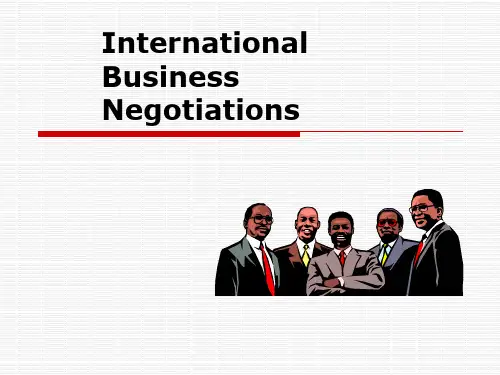

第二章国际商务谈判的基本理论•第一节结构理论及其在国际商务谈判中的应用•第二节需求理论及其在国际商务谈判中的应用•第三节行为学理论及其在国际商务谈判中的应用•第四节心理学理论及其在国际商务谈判中的应用•第五节博弈论及其在国际商务谈判中的应用•上世纪50年代至今,美日之间的贸易摩擦与贸易谈判绵延不绝,在现代贸易史上极具代表性和典型性。
美日贸易谈判,无论在过程结构和实力结构、行为、心理,以及谈判层次、类型、频率、对象和方式上都有较大的研究价值。
•二战后,日本经济在较短时间内得以恢复并实现了赶超,上世纪60年代末就成为西方世界第二经济大国和强国。
不过,与此相伴随,上世纪50年代中后期开始,日本就与美国在纺织品、皮革贸易上发生了摩擦,此后一路升级,在钢铁、家电、机床、汽车、半导体等领域的贸易摩擦愈演愈烈,日本经济实力的增强也让美国产生了较大的警惕心理,“日本威胁论”喧嚣一时。
•1985年9月,《广场协议》签署后,日元大幅度升值,却并没有改变美日贸易失衡的局面,日本对美贸易顺差仍然居高不下,贸易政策成为美国对外关系的焦点议题。
美国国会通过了《1988年综合贸易与竞争法》之后,美国开始寻求与日本进行贸易谈判,日本也意识到应该把谈判作为一种管控美日经济关系困境的方式。
•1989年7月,美日贸易谈判开启。
两国共同组建了一个联合工作小组,其中包括美国的六个部门,国务院、财政部、贸易代表为三个共同主席,还有商务部、司法部和经济顾问委员会。
日本的外务省、大藏省、通产省(经产省前身)为三个共同主席,经济企划厅和公平贸易委员会是小组成员。
随着谈判的不断深入,联合小组也有所扩大,不断有其他部门加入到谈判当中。
•第一阶段谈判于1989年9月4日至1990年1月30日进行。
由于美日各执一词,双方分歧较为严重,谈判进展缓慢,一度陷入僵局。
美国列出了240项条款清单,涉及事项繁多,使得日本深为不满。
美国国内舆论则要求对日本采取更为强硬的政策,两国政治经济关系陷入紧张状态。
•第二阶段谈判于1990年1月31日至4月5日进行,取得了重大突破,达成了中期报告,取得了阶段性成果。
1990年1月31日,两国在瑞士伯尔尼举行秘密会谈。
谈判的性质也由单纯的经贸谈判逐渐政治化。
日本在相关议题上做出了妥协,美国也在削减财政赤字等议题上做出了让步。
1990年4月5日,双方达成了中期报告,两国政府均表示中期报告意义重大。
•经过磋商,两国于1990年6月28日签订了最终协议。
•此后,美国和日本政府又在贸易问题上进行了相应的谈判,但频次有所下降,谈判的议题也开始多样化。
•一、谈判的过程结构理论及其在国际商务谈判中的应用•(一)谈判的过程结构理论的主要内容•谈判结构理论的代表人物是马什和斯科特。
其中,马什通过对谈判结构的研究,提出了一套纵向谈判结构。
马什认为,一次商务谈判通常是由六个阶段构成的,即计划准备阶段、开始阶段、过渡阶段、实质性谈判阶段、交易明确阶段、谈判结束阶段。
•斯科特则从横向方面规划出一套谈判结构。
他认为:任何一次商务谈判实际上就是一次运用谈判技巧的实践,而谈判技巧则是谈判者以心理学、管理学、社会学、经济学、政治学、法学等为指导,并在长期的实践中逐渐形成的,以丰富实践应验为基础的本能行为或能力,此种本能行为将受到一定的谈判方针所规范和驱动。
•马什的纵向谈判和斯科特的横向谈判结构理论被广泛运用。
大多数谈判类教材的编写都是按照纵向和横向的章节顺学编排的,本书也是如此;同时,众多的谈判工作者也都十分推崇二人的理论,他们在实际工作中也往往将两者结合起来,即首先按照马什的纵向结构论将谈判划分为若干个阶段,然后在各个阶段按照斯科特的横向结构论策划出基本的谈判方针,并根据基本的谈判方针去规范和驱动各阶段的谈判。
•谈判的实力结构理论是霍普金斯大学教授威廉姆·扎特曼提出来的。
扎特曼认为,现有的谈判理论过于强调了谈判者性格的影响,虽然谈判者的性格对谈判的过程及其结果有重要的影响,但在谈判中起决定性作用的往往是谈判的结构,尤其是谈判的实力结构,谈判的实力结构决定了谈判的形式和结果。
•谈判实力结构理论重要分析了谈判双方之间的实力处在不同结构下的可能结果。
•实力是与时间和金钱不一致的一种要素。
当然,在任何谈判中,双方在其中一项事情的实力上是对称的,就是双方都有权否决谈判协议或合同。
•在前面做出让步的谈判者希望谈判对手也能够做出让步作为回报,如若不然,他们就会有一种被欺骗的感觉,从而在最后拒绝签署谈判合同。
更进一步地说,即使除了基本否决权之外,谈判者的实力并不均衡,但是他们仍然希望通过互惠实现动态平衡。
•由于完全公平的结果和完全平等的谈判方一样在现实中几乎不可能存在,因此,从对称得出的结论表明,当谈判者将个别的讨价还价变为整体协商的时候,仍然会尽他们最大的努力,将讨价还价的边界推向最优的交换结果,尽量使他们从谈判中得到最大的收益。
•实际上,谈判的实力结构平等可以使双方免于纠缠立场平等问题,而把精力专注于为平等的结果创造更大的收益蛋糕。
也就是说,要得到整体收益为正的结果,最重要的不是绝对平等地分配蛋糕,而是进行平等的交换。
•由于谈判实力较强的一方通常在讨价还价中拥有更的影响力,实力较弱的一方在谈判的准备阶段就应该采用适当的策略,比如,通过运用制造竞争、借助外力干预等达到增强本方实力的目的。
•所以,谈判的实力结构理论为国际商务谈判中各种谋略和技巧的运用提供了充分的理论依据。
•一、需求层次论的主要内容及其在国际商务谈判中的应用•需求层次论是由心理学家马斯洛(A.Maslow)提出来的,这是一个受到广泛关注的理论。
•马斯洛的需求层次论把人的需要分成生理需要、安全需要、友爱和归属的需要、尊重的需要、自我实现的需要五个层次,在1954年他又在《激励与个性》一书中,在尊重的需要后面又增加了求知的需要的求美的需要,把人的需要分成七个层次。
按其重要性依次是:•1.生理的需要•2.安全的需要•3.友爱和归属的需要•4.尊重的需要•5.求知的需要•6.求美的需要•7.自我实现的需要•马斯洛认为人们的上述需要基本反映了在不同文化环境中人类的共同特点。
人类的需要基本是由低级到高级以层次出现的,当某一层次的粗要得到相对满足时,其激发动机的作用随之减弱和消失,此时更高层次的需要则成为新的激励因素。
因而,人类的基本需要是一种有相对优势的层次结构。
•1.为摸清谈判对象的动机提供了理论基础•2.为多种谈判方案的制定提供理论基础•3.为谈判谋略和技巧的运用提供了理论依据•需求价格弹性在国际商务谈判中最大的用途,是帮助出口商作出价格决策。
在需求有弹性的情形中,适宜采取降价的决策;而在需求弹性小的情形中,则适宜采取提价的决策,由于非弹性需求的商品,一般为生活必需品,提价对消费者的购买行为影响相对要小一些。
•需求收入弹性对于进出口商的经营决策具有重要的意义。
因为需求收入弹性表明需求变动与收入变动的关系,为进出口商掌握随收入变动而引起的需求变动趋势,进而为决定其经营、销售决策提供了有用的分析和预测工具。
•一、行为学理论的产生及其主要内容•行为学是20世纪中期兴起的理论思潮和边缘学科,它借助了数学、生物学等自然科学和人类学、心理学等社会科学的各项研究成果,得出了一些较有价值的分析结论,这些结论反过来又被应用到经济学、管理学、人类学、生物学等的研究中。
•根据行为学的研究,任何事物的运动都有其内部原因和外部原因,人的行为也不例外,影响人的行为的因素可以从内、外两个方面去寻找。
•影响人的行为的个人主观的内在因素主要包括生理因素、心理因素、文化因素和经济因素。
其中,生理因素包括遗传因素、体质状况、生理需要、生物节律规律等方面。
心理因素涉及到包括感觉、知觉、思维和认识在内的心理活动过程;包括价值观、理想、信念和态度在内的个性倾向性心理特征;包括气质、性格和能力在内的个性非倾向性心理特征。
文化因素包括个人所接受的文化教育、专业技术、职业道德观念、礼仪等。
经济因素主要指个人所处的经济地位。
•影响人的行为的外在环境因素主要包括组织的内部环境因素和组织的外部环境因素。
其中,组织的内部环境因素涉及到群体、领导和整个组织三个方面,群体方面包括人际关系、信息沟通、内聚力、冲突与气氛等;领导方面包括领导素质、领导作风与方法、激励方法与制度等;整个组织方面包括组织设计、组织结构、规章制度、工作设计、组织文化、组织变革、绩效考核等。
组织的外部环境因素包括条件因素和人群团体因素。
条件因素主要涉及国内及国际的经济、社会文化、政治法律、自然地理等;人群团体因素包括的内容比较多,如家庭、亲友、产权所有者、竞争者、客户、供应商、各级政府、群众团体等。
•从影响人的行为的诸因素可以看出,行为学理论在国际商务谈判中有着非常广泛的应用,从谈判开始前的环境因素分析、信息收集,到谈判人员的配备和管理,谈判方案的制定,以及谈判桌上的双方争斗,国际商务谈判的礼仪等,都离不开行为学理论研究成果的指导。
也可以这样说,从全局的角度看,行为学理论是对国际商务谈判影响最大的一门科学。
•一、心理学理论的主要内容•从心理学理论的发展史可以看出,心理学研究起步早,流派众多,研究成果比较丰富,这里主要介绍在中国颇有影响的奥地利的精神病医学家弗洛伊德及其学生荣格和阿德勒的理论。
•弗洛伊德认为,人的个性是一个整体,在这个整体之内包括着彼此关联而相互作用的三个部分。
这三个部分分别称为本我、自我、超我。
由于这三部分的相互作用而产生的内在动力,支配了个人的所有行为。
•弗洛伊德认为,本我寻求满足,自我考虑到现实环境的限制,超我则按社会规范来衡量是、非、善、恶。
并且指出,本我、自我和超我三者不是分立的,乃是彼此相互作用而构成的个性整体。
本我的冲动与欲望应该在合于现实条件下,为社会规范所允许下,得到适当的满足。
•荣格是弗洛伊德的杰出的学生,两人的理论有下列三个不同点:•(1)承认潜意识是支配行为的内在因素,但主张潜意识有两种:一种叫做个人潜意识,是由个人压抑自己的意识经验而形成的,另一种叫集体潜意识,是由人类多代遗传演化积累而形成的。
两种潜意识一同支配人的行为。
•(2)个性的发展并不取决于人本能的冲动,而是由于个人为达到自我实现的内在潜力所引导。
•(3)自我才是个性结构的核心,而自我又取决于两种“态度”或倾向,一种为外向,一种为内向。
•荣格后来又发展了自己的理论,把人在生活中特别在与人交往中的性格特点分为敏感型、感情型、思考型和想像型四类。
虽然一个人可能同时具有两种或两种以上的性格类型特点,但其所具有的主要特征总是属于某一类型的。
•阿德勒也是弗洛伊德的学生,后因与其老师的观点不同而分离。
•阿德勒不过分注重生物或本能的因素,而是转而强调人个性发展中的社会因素。